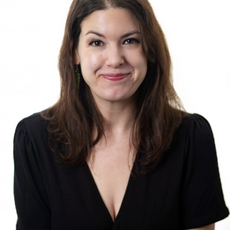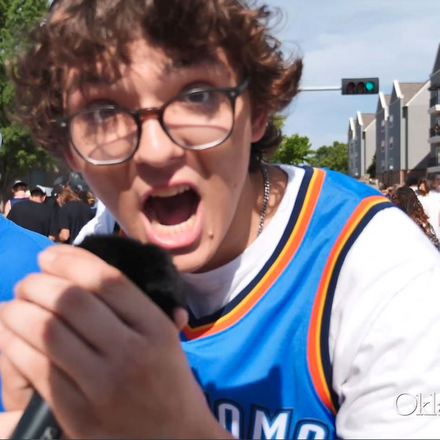OU and OSU's Masterpiece Museums
Published October 2024
By Megan Rossman | 14 min read
In Oklahoma, school pride reigns big, particularly when it comes to the two acronyms that need no clarification: OU and OSU. While alma maters and athletics tend to dominate allegiances, both universities are home to institutions that sometimes fly under the radar. There’s no experience in Oklahoma quite like cheering yourself hoarse on game day, but those wanting to explore local culture a little further will find themselves a stone’s throw from world-class art collections in either location, with the Fred Jones Jr. Museum of Art in Norman and the OSU Museum of Art in Stillwater.

The Fred Jones was born at the University of Oklahoma in the 1920s, when professor Oscar B. Jacobson began amassing an art collection for the college. It was officially coined the Oklahoma University Museum of Art in 1936, with Jacobson serving as the director until he retired in 1950. In 1971, Oklahoma City civic leaders Fred and Mary Jones donated the funds to create a building for the museum on campus, named in honor of their late son. Several renovations and additions later, the Fred Jones now sits at a sprawling 40,000 square feet. And though it’s situated at a school, Thomas Brent Smith, the Fred Jones’ Wylodean and Bill Saxon Director, emphasizes this space is meant for the public.
“I want people to know that the art museum is for everyone,” says Smith. “In no way is it just for students. And, in fact, something that might surprise most people is that the majority of our visitors are not associated with the university.”
Inside, those visitors will find a walking tour of little surprises around each corner. As guests peruse the bright temple-like hallways—and a new café and gift shop on the ground floor—they’ll find themselves suddenly in what appears to be the genteel parlors of someone’s grand estate. This is The Aaron M. and Clara Weitzenhoffer Collection, the largest donation of French impressionism ever made to a public university—and the most valuable single donation of art ever given to a public university. Thirty-three works by French masters like Van Gogh, Rousseau, Renoir, Monet, and Gauguin decorate this space inspired by the Weitzenhoffer family’s Oklahoma City home. Other galleries throughout the Lester Wing contain pieces from every era from every part of the world, from Papua New Guinean masks and paintings of pre-Renaissance Madonnas to Machine-Age modernism and a Nigerian dance wand—a ritual object used in worship ceremonies to honor the Yoruba people’s god of thunder.
.jpg)
Suburb under Snow (Winter Day) was painted in 1886 by Paul Gauguin and is displayed at OU’s Fred Jones Jr. Museum of Art with other works from The Aaron M. and Clara Weitzenhoffer Collection. Fred Jones Jr. Museum of Art, The University of Oklahoma, Norman; Aaron M. and Clara Weitzenhoffer Bequest, 2000
“I would say one of the special things about Fred Jones is that our permanent collection is so amazing,” says Smith. “It really is, and it’s among the very best collections of any university art museum in America. It aspires to be encyclopedic in the sense that it intends to have artworks from all over the world.”
The glowing red eyes of a towering fiberglass mustang overlook the continuation of the permanent collection on the second floor. Luis Jiménez’s Mustang (Mesteño) is startling to happen upon—but hard to look away from. A larger version of it, infamously on display at the Denver International Airport, ultimately killed its sculptor: As he was constructing it, a large piece fell off, severing an artery in his leg. The deadly statue’s small brethren looms over a vast and vibrant assemblage of Western and Indigenous art at Fred Jones that includes selections from the James T. Bialac and Eugene B. Adkins collections, the latter of which is shared with the Philbrook Museum of Art in Tulsa. Together, they comprise approximately 7,500 works that include famous names like Albert Bierstadt and Allan Houser and unknown Southwestern artisans.

*Rochambeau* is a piece created from ceramic, leather, paper, and steel by New Mexico-based artist Cannupa Hanska Luger in 2013. Fred Jones Jr. Museum of Art, The University of Oklahoma, Norman; The James T. Bialac Native American Art Collection, 2010
%20copy.jpg)
*Mustang (Mesteño)* was created by Luis Jiménez in 1997. Its larger version is a famous landmark at the Denver International Airport. Fred Jones Jr. Museum of Art, The University of Oklahoma, Norman; Gift of Jerome M. and Wanda Otey Westheimer, 1998
Along with the permanent galleries, the basement and mezzanine levels host several rotating exhibits each year. On October 4, the gallery opened a show dedicated to Oklahoma’s own iconic Frankoma Pottery.
As Fred Jones looks toward the future, its staff continues to build on its goals and offerings, most recently redefining its mission statement: “We transform lives through experiences with art.”
“What’s sort of guiding us into the future is that we want to be more connected to our community—that being our campus community, as well as our greater community,” says Smith. “We’re expecting different things from museums. It used to be that we’d go and expect to look at things and learn from those. Now, we expect museums to be places where we engage. Museums, first and foremost, are places that you should enjoy yourself.”
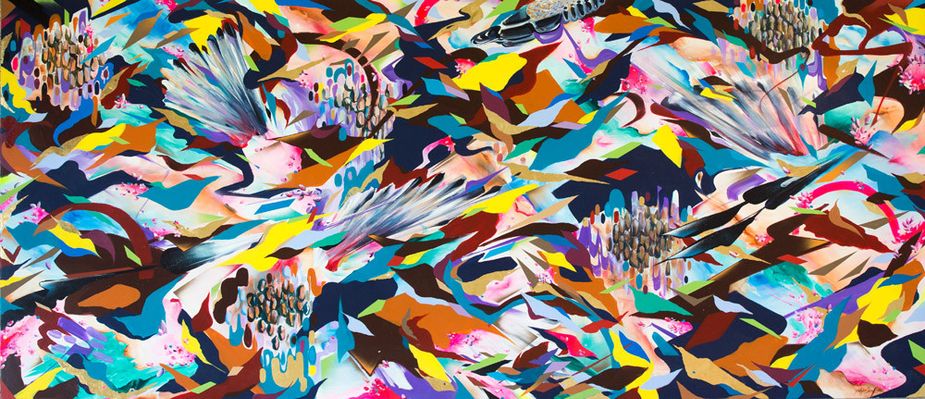
Connecting Roads from Past to Present, acrylic, spray paint, and gold leaf on canvas by Yatika Starr Fields, is one of two large murals on display in the OSU Museum of Art lobby. Image courtesy Phil Shockley/OSU Museum of Art
Those senses of fun and engagement are overarching goals at the OSU Museum of Art in Stillwater, as well, which has been celebrating its ten-year anniversary with exhibits and events throughout 2024.
“We are not a quiet museum,” says marketing coordinator Casey Pankey-Ihde.
In fact, OSU is what Pankey-Ihde and the staff call a teaching museum, where people can drop in to view the galleries and get hands-on learning experiences.
“We like the ideas of community building, lifelong learning, and creative expression,” she says. “We want to foster that and help people find their entry point. I also think visual literacy is something that’s critical in today’s world, and it’s a skill we all need desperately. Being able to sit and view artwork—and to think about it and talk about it—helps build that skill.”
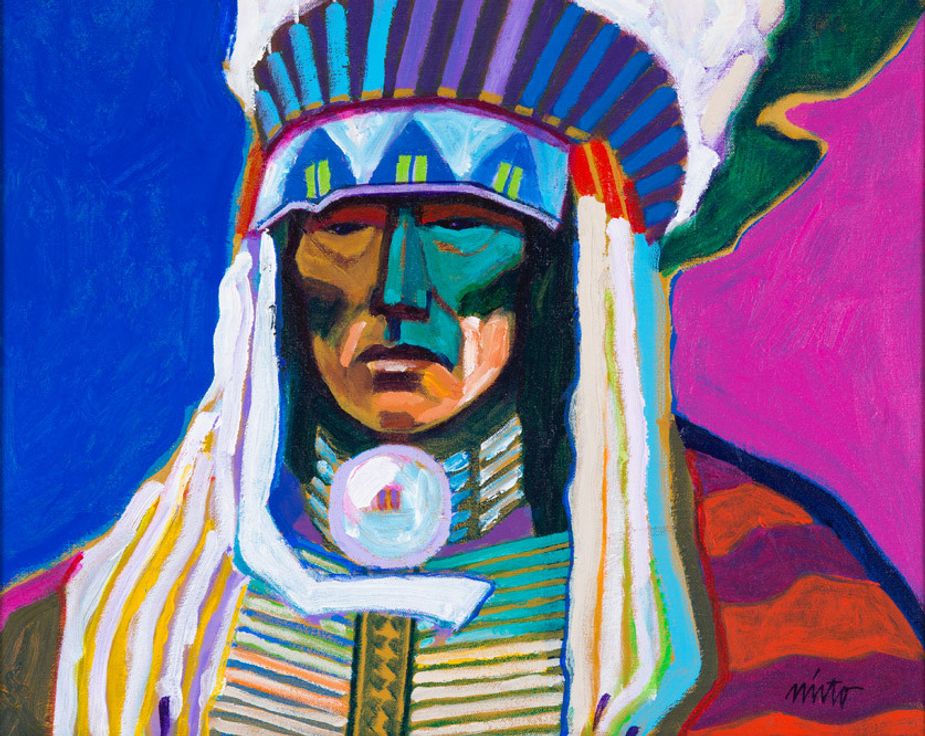
Chief Rain in the Face by John Nieto, acrylic on canvas OSU Museum of Art
The museum’s Malinda Berry Fischer Gallery rotates exhibits that generally draw from its permanent collection, which includes more than five thousand works from artists like Roy Lichtenstein, Frank Lloyd Wright, Leon Polk Smith, Acee Blue Eagle, and Doel Reed, to name a few. Two murals—The History of Payne County by Grace Hamilton and the colorfully kinetic Connecting Roads Past to Present by Tulsa artist Yatika Starr Fields—greet visitors in the lobby, while the George R. Kravitz Gallery mainly hosts traveling exhibits. Upcoming exhibits include visceral animal sculptures in Jessica Teckemeyer: Healing Through Conflict through October 19, and dramatic black-and-white images in Shadows and Light: The Photography of Brett Weston from October 29 to February 1.
On the activities front, the museum hosts several ongoing programs, the most well-attended being Second Saturdays. Particularly popular among families but open to everyone of all ages and abilities, these OSU-organized art projects take place at the museum.
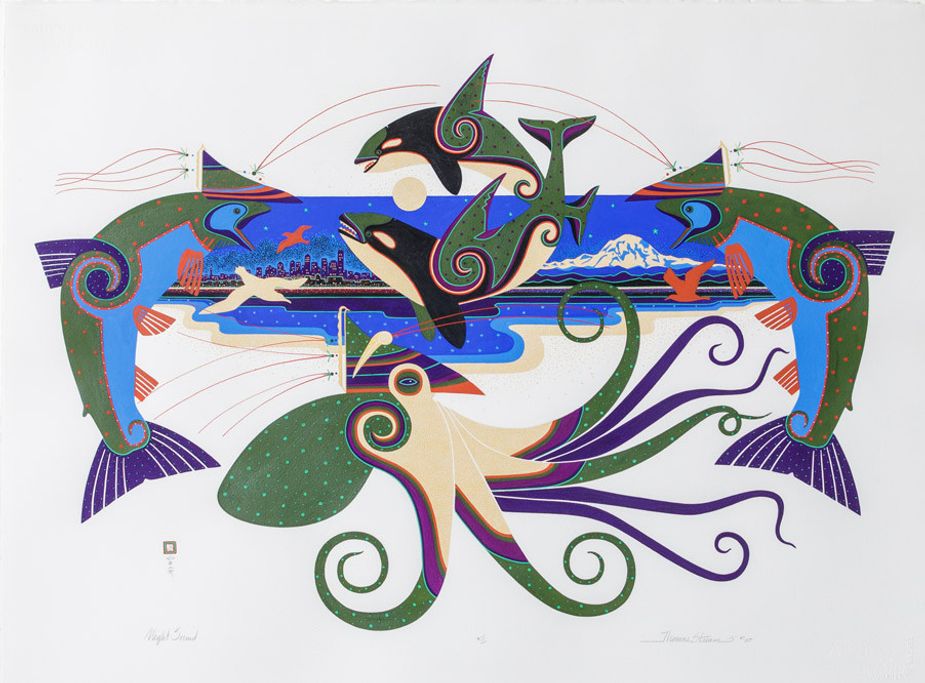
Night Sound by Thomas Stream, 2007, gouache on paper, is in the OSU Museum of Art’s permanent collection. OSU Museum of Art

Jessica Teckemeyer’s sculptural works will be on display August 13 to October 19 in her solo exhibit Healing Through Contact at the OSU Museum of Art. This piece made from polyurethane, silicone, glass, wood, and paint is called Rivalry. Jessica Teckemeyer
Additional offerings include weekly events like Wednesday Weaving, where participants use looms to weave fabric and paper. On Thursdays, the Drop-in-and-Draw easel set-up in the galleries invites visitors to create their own works of art using dry materials like pencils or charcoal; Friday Flix during the school year shows documentaries and artist profiles; and the Saturday Collage Club is just what it sounds like: groups of people gathering to piece together collages made from a variety of media in the artLAB—a makerspace stocked with materials that’s open any time the museum is. An added bonus? Programs and admission are all free at the OSU Museum of Art.
“We’ve really loved being able to see all our visitors coming in and finding inspiration,” says Pankey-Ihde. “It’s a nice space to just take a breath, you know?”
The space to breathe is perhaps the main draw of most museums. In an age with so much emphasis on automation and productivity, these institutions are more important than ever, offering zephyrs of inspiration and possibility. Whether they’re quiet places where footsteps echo among French masterpieces or spaces buzzing with the creativity and screeches of a dozen children cutting up construction paper, they provide a safe harbor for people to get lost in their imaginations, discussions, and endeavors—and have a little fun.
Long Pause
Stay tuned for a reimagined Gilcrease Museum in late 2026.
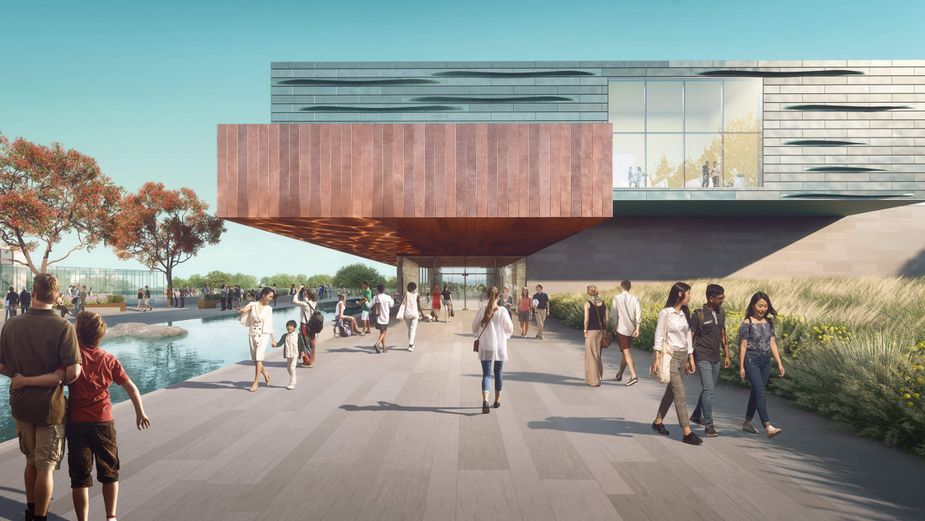
Since oil magnate and art collector Thomas Gilcrease opened it to the public in 1949, the Gilcrease Museum in Tulsa has been one of the region’s premier cultural destinations. Owned by the City of Tulsa and managed by the University of Tulsa, the museum closed its doors in 2021 for a complete demolition. In place of the museum’s aging buildings, an 83,500-square-foot facility that broke ground in spring 2022 is expected to open to the public toward the end of 2026. Along with gallery space, the reimagined property will be surrounded by 460 acres of grounds. As visitors await this new destination, they still can learn about works from the Gilcrease collection in the course of their other outings. Displayed in outdoor settings around the greater Tulsa area—Turkey Mountain, Oxley Nature Center, Gathering Place, Keystone Ancient Forest, and the Ray Harral Nature Center—these works of art change every six months.
